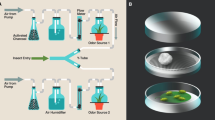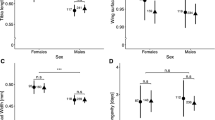Summary
In the wing dimorphic milkweed-oleander aphid,Aphis nerii, winged aphids begin reproducing about 1.5 days after wingless aphids. The longer maturation period is primarily due to slower development since even adult eclosion by winged aphids takes place after wingless aphids begin reproducing. The delay is not due to a post-eclosion, pre-reproductive flight since, beginning with the fourth instar, larval winged aphids were reared at a density of one per plant and the vast majority were not stimulated to fly under such low-density conditions. Thus, the ability to fly incurs a fitness cost in terms of delayed reproduction, irrespective of whether flight actually occurs. We did not observe a difference between morphs for lifetime fecundity, even though wingless aphids have larger abdomens than winged aphids and for both morphs there is a significant correlation between abdomen width and fecundity. Offspring produced by wingless aphids over the first four days of reproduction are larger than those produced by winged aphids, and the size difference at birth is maintained into adulthood. However, there are no differences in life history traits between these offspring, including maturation period and lifetime fecundity. Thus, reduced body size does not increase the cost of being able to fly, at least under the conditions of these experiments. The cost of being able to fly in this species should favor reduced production of winged individuals in populations that exploit more permanent host plants.
Similar content being viewed by others
References
Blackman, R.L. (1979) Stability and variation in aphid clonal lineages.Biol. J. Linn. Soc. 11, 259–77.
Blackman, R.L. and Eastop, V.F. (1984)Aphids on the World's Crops: An Identification and Information Guide. Wiley-Interscience, IL, USA.
Bodenheimer, F.S. and Swirski E. (1957)The Aphidoidea of the Middle East. Weizmann Science Press of Israel, Jerusalem.
Campbell, A. and Mackauer, M. (1975) Thermal constants for development of the pea aphid (Homoptera: Aphididae) and some of its parasites.Can. Ent. 107, 419–23.
Cannon, R.J.C. (1984) The developmental rate ofMetopolophium dirhodum (Walker) (Hemiptera: Aphididae) on winter wheat.Bull. Ent. Res. 74, 33–46.
Carroll, D.P. and Hoyt, S.C. (1986) Some effects of parental rearing conditions and age on progeny birth weight, growth, development, and reproduction in the apple aphid,Aphis pomi (Homoptera: Aphididae).Envir. Ent. 15, 614–19.
Denno, R.F. (1985) Fitness, population dynamics and migration in planthoppers: The role of host plants.Migration: Mechanisms and Adaptive Significance. M.A. Rankin (ed.),Contrib. Mar. Sci. (Suppl.)27, 623–40.
Dingle, H. (1982) The function of migration in the seasonal synchronization of insects.Ent. Exp. Appl. 31, 36–48.
Dingle, H. (1986) Evolution and genetics of insect migration.Insect Flight: Dispersal and Migration. W. Danthanarayana (ed.), pp. 11–26. Springer-Verlag, New York, USA.
Dixon, A.F.G. (1985)Aphid Ecology. Blackie Glasgow, UK.
Dixon, A.F.G. and Howard, M.T. (1986) Dispersal in aphids, a problem in resource allocation.Insect Flight: Dispersal and Migration. W. Danthanarayana (ed.), pp 145–51. Springer-Verlag, New York, USA.
Dixon, A.F.G. and Wratten, S.D. (1971) Laboratory studies on aggregation, size and fecundity in the black bean aphid,Aphis fabae Scop.Bull. Ent. Res. 61, 97–111.
Harrison, R.G. (1980) Dispersal polymorphisms in insects.Ann. Rev. Ecol. Syst. 11, 95–118.
Hutchison, W.D. and Hogg, D.B. (1984) Demographic statistics for the pea aphid (Homoptera: Aphididae) in Wisconsin and a comparison with other populations.
Johnson, B. (1953) Flight muscle autolysis and reproduction in aphids.Nature 172, 183.
Johnson, B. (1957) Studies on the degeneration of the flight muscles of alate aphids. I. A comparative study of the occurrence of muscle breakdown in relation to reproduction in several species.J. Insect. Physiol. 1, 248–66.
Johnson, C.G. (1969)The Migration and Dispersal of Insects by Flight. Methuen, London, UK.
Lenski, R.E. and Service, P.M. (1982) The statistical analysis of population growth rates calculated from schedules of survivorship and fecundity.Ecology 63, 655–62.
Llewellyn, M. and Brown, V.K. (1985) A general relationship between adult weight and the reproductive potential of aphids.J. Anim. Ecol. 54, 663–73.
MacKay, P.A. and Wellington, W.G. (1975) A comparison of the reproductive patterns of apterous and alate virginoparousAcrythosiphon pisum (Homoptera: Aphididae).Can. Ent. 107, 1161–6.
Murdie, C. (1969) The biological consequences of decreased size, caused by crowding or rearing temperatures in apterae of the pea aphid,Acyrthosiphon pisum Harris.Trans. Roy. Ent. Soc. Lond. 121, 443–55.
Rankin, M.A. (1986) The oogenesis-flight syndrome revisited.Insect Flight: Dispersal and Migration. W. Danthanarayana (ed.), pp 27–48. Springer-Verlag, New York, USA.
Roff, D.A. (1984) The cost of being able to fly: A study of wing polymorphism in two species of crickets.Oecologia 63, 30–7.
Roff, D.A. (1986) The evolution of wing dimorphism in insects.Evolution 40, 1009–20.
SAS Institute (1985)SAS User's Guide: Statistics. SAS Institute, Cary, NC, USA.
Shu-seng, L. and Hughes, R.D. (1987) The influence of temperature and photoperiod on the development, survival and reproduction of the sowthistle aphid,Hyperomyzus lactucae.Ent. Exp. Appl. 43, 31–8.
Sokal, R.R. and Rohlf, F.J. (1969)Biometry, Freeman, San Francisco, USA.
Southwood, T.R.E. (1977) Habitat, the template for ecological strategies?J. Anim. Ecol. 46, 337–65.
Southwood, T.R.E. (1987) Habitat and insect biology.Bull. Ent. Soc. Amer. 33, 211–14.
Taylor L.R. (1975) Longevity, fecundity, and size: control of reproductive potential in a polymorphic migrant,Aphis fabae Scop.J. Anim. Ecol. 44, 135–63.
Watt, A.D. (1984) Reproductive strategies of the alate and apterous morphs of the grain aphid,Sitobion avenae.Ent. Exp. Appl. 36, 3–7.
Williams, C.T. and Wratten, S.D. (1987) The winter development, reproduction and lifespan of viviparae ofSitobion avenae (F.) (Hemiptera: Aphididae) on wheat in England.Bull. Ent. Res. 77, 19–34.
Winer, B.J. (1971)Statistical Principles in Experimental Design, 2nd edn. McGraw-Hill, New York, USA.
Zera, A.J. (1984) Differences in survivorship, development rate and fertility between the long-winged and wingless morphs of the waterstrider,Limnoporus canaliculatus. Evolution38, 1023–32.
Author information
Authors and Affiliations
Rights and permissions
About this article
Cite this article
Groeters, F.R., Dingle, H. The cost of being able to fly in the milkweed-oleander aphid,Aphis nerii (Homoptera: Aphididae). Evol Ecol 3, 313–326 (1989). https://doi.org/10.1007/BF02285262
Issue Date:
DOI: https://doi.org/10.1007/BF02285262




